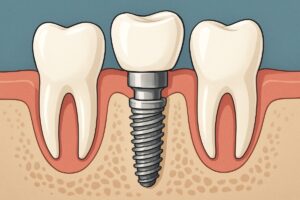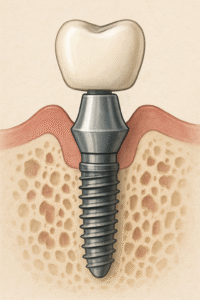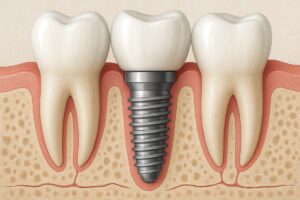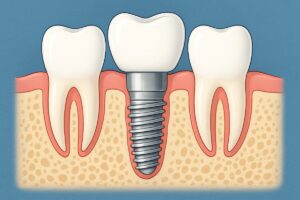A simple, clear intro that explains this quick guide will walk readers through the process of a tooth implant and what to expect from first consult to finished crown. This quick guide explains the process of a tooth implant so you know each step, typical timelines, and how to prepare.
What is a tooth implant?
A tooth implant is a small titanium or ceramic post placed into the jawbone to replace a missing tooth root. It supports an abutment and a crown (or a bridge/prosthesis). Implants restore chewing, speech, and the look of natural teeth, and they help protect nearby teeth and bone.
The process of a tooth implant: step-by-step
1. Initial consultation and treatment planning
Your dentist reviews medical and dental history, examines your mouth, and discusses goals. Expect questions about health, medications, and habits like smoking. The doctor explains options and creates a personalized plan with estimated timeline and costs.
2. Advanced imaging and digital scans
CBCT (3D X-rays) and intraoral scans map your jaw, nerves, and sinuses. These images let the team plan the exact implant position and size for better safety and predictability. Digital files also speed up lab work and restoration design.
3. Implant placement surgery
Placement is done with local anesthesia; IV sedation is an option for nervous patients. The surgeon places the implant into the bone; patients may feel pressure but usually little pain during the procedure. Most placements take under an hour for a single implant.
4. Healing and osseointegration
Bone naturally fuses to the implant (osseointegration) over weeks to months. Typical healing is 3–6 months, depending on bone quality and any grafts. Temporary crowns or removable teeth can be used while you heal.
5. Abutment and final restoration
Once healed, the abutment is attached to the implant. The dentist takes impressions or digital scans, then places a custom crown, bridge, or prosthesis—often made from zirconia—for a natural look and strong function.
6. Follow-up care and maintenance
Regular check-ups and good home hygiene keep implants healthy. Brush, floss, and use interdental brushes as recommended. Report pain, swelling, or loose parts to your dentist right away. Follow-up care and maintenance are crucial for long-term success.
How long does the whole process take?
Most single-tooth implant cases take 3–6 months from placement to final crown. Factors that extend time include bone grafts, smoking, uncontrolled medical conditions, or the need for sinus lifts. Some patients qualify for faster protocols or immediate restorations.
Who is a good candidate, and common reasons people choose implants
Good candidates have stable health, enough bone or can receive a graft, and good oral hygiene. People choose implants to improve chewing, restore confidence, preserve jawbone, and avoid altering nearby teeth (as with bridges).
Risks, success rates, and how technology improves outcomes
Complications are uncommon but can include infection, nerve irritation, or implant failure. Success rates exceed 90–95% in healthy patients. CBCT, digital planning, in-house labs, zirconia restorations, and soft-tissue lasers all improve precision and outcomes. Learn more about our team and how technology improves outcomes.
How to prepare for your implant appointment and recover comfortably
Follow pre-op instructions: avoid certain meds if instructed, arrange a ride if sedated, and fast if needed. After surgery, expect swelling and light discomfort—use ice, rest, and prescribed pain meds. Eat soft foods and keep the site clean.
Why consider Grand Dental Implant Centers for your tooth implant
Grand Dental Implant Centers offers implant-focused teams across Illinois with CBCT imaging, intraoral scanning, in-house labs, and zirconia restorations. They provide IV sedation options, full-arch solutions, and financing to help make treatment accessible while keeping care efficient and consistent.
If you’re considering an implant, schedule a consult to review your health, images, and timeline. A personalized plan will show costs, options, and the next steps to restore your smile.






